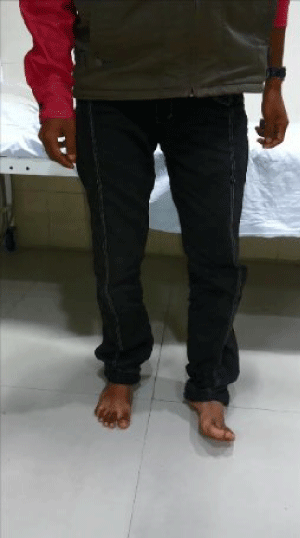
Case Report
Austin J Clin Neurol 2015; 2(9): 1077.
Paroxysmal Kinesigenic Dyskinesia: A Rare Neurological Disorder Posing Diagnostic Challenge but Therapeutic Rewards
Jain RS¹, Prakash S²*, Nagpal K¹ and Handa R¹
¹Department of Neurology, SMS Medical College Hospital, India
²Neotia Getwel Health Care Centre, Siliguri, West Bengal, India
*Corresponding author: Swayam Prakash, Neotia Getwel Health Care Centre, Matigara, Siliguri-734010, India
Received: July 07, 2015; Accepted: August 09, 2015; Published: August 11, 2015
Abstract
Background: Paroxysmal kinesigenic dyskinesia (PKD) is one of the rare hyperkinetic movement disorder, characterized by brief, episodic hyperkinetic movement abnormalities like dystonia, chorea, hemiballismus or a combination, usually precipitated by sudden body movements, e.g. running, walking, standing, turning in bed, etc., lasting usually for a few seconds and followed by a variable period of refractoriness. By rule, consciousness is preserved and it usually responds well to antiepileptic drugs (AEDs).
Objective: To report clinical and demographic profiles of a series of three cases of sporadic PKD.
Observation: Three cases of idiopathic PKD, all male, two of them had onset in the second decade and one in the third decade, without a family history, with variable phenomenology, duration and precipitants but with remarkable response to carbamazepine.
Conclusion: A high index of suspicion should be maintained as diagnosis of PKD is largely clinical and accurate diagnosis is rewarded with remarkable therapeutic response with AEDs.
Keywords: PKD; PNKD; PED; PHD; Dykinesias; Hyperkinetic; Shoot-run; AEDs
Introduction
Paroxysmal kinesigenic dyskinesia (PKD) is one of the rare episodic hyperkinetic movement disorders, with typical childhood onset [1]. Other paroxysmal dyskinesias are paroxysmal nonkinesigenic dyskinesias (PNKD), paroxysmal exercise-induced dykinesias (PED) and paroxysmal hypnogenic dyskinesias (PHD) [2]. Family history is usually positive; however, sporadic cases are frequently reported [1,2]. We are reporting three cases of PKD with varying manifestations, without family history, and remarkable symptomatic improvement following treatment.
Case Presentation 1
A 22-year-old male, fresh paramilitary recruit, without any significant past, personal or family history presented with episodes of dystonic posturing, consisting of twisting and inward turning of left upper limb, turning of the head towards right and mild dysarthria but without loss of consciousness, at the start of ‘shoot-run’ (a run which entails very fast running from the word go and is a part of training of military and paramilitary recruits) (Figure 1/Video 1); for last two months, when he was inducted into such physical training. The episode abates completely within half or a minute after stopping and does not recur if he resumes running after subsidence of symptoms. This episode recurs only on restart of run after a period of quiescence. There is no history of occurrence of similar symptoms in other limbs; neither do these episodes occur with any activity other than ‘shootrun’.

Figure 1: Dystonic posturing of left upper limb consisting of internal rotation
at shoulder, extension at elbow and wrist, and flexion of fingers with rightward
deviation of head and neck.
Video - 1
Please download Video here
Case Presentation 2
An 18-year-old male, without any significant past, personal, family or developmental history presented with brief episodes of abnormal posturing of limbs, lasting for 5-10 seconds and brought on by sudden movements, e.g. sudden standing, walking or running, for last six years. The episode usually comprised of inversion and stiffness of left foot and dorsiflexion of toes, (Figure 2/Video 2) with occasional bilateral or right sided manifestation but without loss of consciousness. Once the episode is over it does not recur for some time, even on making sudden moves. Episodes were less frequent initially, like once in a week or a month, but have increased in frequency up to five to ten times in a day, over last two years.

Figure 2: Dystonic posturing of left foot with dorsiflexion and inversion at
ankle and dorsiflexion of toes.
Video - 2
Please download Video here
Case Presentation 3
A 19-year-old male without any significant past, personal or family history, presented with a five years history of brief episode of dystonic posturing of limbs, lasting for 5-10 seconds, consisting of inversion at ankle, dorsiflexion of great toes along with flexion at elbow, wrist and fingers (Figure 3/Video 3). Usually these abnormal posturing are present on the right side, but occasionally may involve all four limbs, without loss of consciousness. The episode is brought on by sudden standing, walking or running, however, not after heavy manual work and once the episode is over, it does not recur for variable period even with continued activity.

Figure 3: Dystonic posturing of bilateral lower limbs and right upper limb,
consisting of inversion at ankle, dorsiflexion of great toes alongwith flexion at
elbow, wrist and fingers.
Video - 3
Please download Video here
General examination, including KF-ring and other systemic examination were within normal limits in all three cases. Neurological examination was also normal except during the episode of described abnormal movements.
Investigations
In all three cases, MRI-brain and ambulatory EEG (during the episode) were normal. Peripheral blood smear was negative for acanthocytes and other lab investigations, including serum electrolytes, parathyroid and thyroid profiles were within normal limits.
Differential diagnosis
Based on the above clinico-historical observations supported by normal imaging and EEG findings a diagnosis of PKD was made. PED was considered a close differential, but as PED is precipitated by prolonged physical exercise and marked by a longer lasting (5- 30 minutes) episode, it was essentially ruled out. Nonepileptic psychogenic movement disorder was also thought of, but brevity of episode with fixed pattern associated with a particular precipitating movement, presence of variable refractory period and lack of secondary gains were points against this diagnosis.
Treatment
All the three patients were initiated on carbamazepine 100mg b.i.d. with gradual build up.
Outcome and follow-up
They showed remarkable symptomatic improvement with virtually no episode by day three in case 1, day four in case 2 and day six in case 3 of the treatment.
Discussion
Paroxysmal kinesigenic dyskinesia is one of the rare episodic hyperkinetic movement disorders, characterized by brief attacks of abnormal involuntary movements comprising of dystonia, chorea, athetosis, hemiballismus or a combination, usually precipitated by sudden movements [3]. PKD is usually idiopathic, however symptomatic or secondary PKDs are also known [1]. Common etiologies for secondary PKD are multiple sclerosis (MS), cerebral vascular insufficiency, metabolic derangements, trauma etc [4]. Other paroxysmal dyskinesias are paroxysmal nonkinesigenicdyskinesias (PNKD), paroxysmal exercise-induced dykinesias (PED) and paroxysmal hypnogenicdyskinesias (PHD) [2].
In PKD, family history is usually present with a male preponderance (80%) and usual age of onset is the first or second decade of life, however, sporadic cases and late onset are also known [1,5,6]. The episode lasts for less than a minute and may occur up to 100 times in a day. Symptoms usually occur unilaterally (Case 1), however, may occur bilaterally or even alternate (Case 2 and 3) [5]. Usually limbs are involved, but neck (Case 1), trunk and face may also be involved. Dysatrhia can also occur occasionally owing to dystonic spasm of the jaw or face muscles, as in Case 1 [5]. There is a refractory period after an attack during which sudden movement may not precipitate the attack [2,5]. Consciousness, by rule, is preserved [5]. Neurological examination is usually normal in between attacks. Ictal or interictal EEG is usually normal and brain imaging is also normal in idiopathic PKD [1,5]. PKD is usually very responsive to anticonvulsant medications, especially carbamazepine and phenytoin [1,2].
Conclusion
All our three cases were young males in their third and second decade respectively, without any family history and with features suggestive of PKD (Table 1). PED was a close differential, however, its occurrence only at the start of the precipitating activity and not with any other strenuous act along with shorter duration of the episode were strong points against [2,5]. Remarkable response to carbamazepine was also a point favoring the diagnosis of PKD.
Case
Age
Sex
Age of onset
Family history
Movement abnormalities
Unilateral/ bilateral
UL/LL
Duration
In seconds
Therapeutic response
1
22
M
22
negative
Dystonia
unilateral
UL
30-60
remarkable
2
18
M
12
negative
Dystonia
Unilateral or bilateral
LL & UL
5-10
remarkable
3
19
M
14
negative
Dystonia
Unilateral or bilateral
LL& UL
5-10
remarkable
Table 1: Showing clinical characteristics of three patients.
To highlight; PKD, though rare, is a treatable neurologic disorder of childhood or young age with a male preponderance and an array of hyperkinetic movement abnormalities, usually precipitated by sudden movements. Diagnosis is largely clinical and importance of accurate diagnosis lies in the fact that it usually responds favourably to anticonvulsant therapy.
Highlights
- PKD is a rare, episodic, short lasting movement disorder of childhood or young age, brought on by sudden movements of the body or a part.
- Usually familial but may be sporadic.
- Diagnosis is largely clinical, role of imaging and other investigations being ruling out secondary causes.
- Response to treatment with AEDs like carbamazepine and phenytoin is fast and favourable.
References
- Daroff RB, Fenichel GM, Jankovic J, et al. Bradley’s Neurology in clinical practice. 6th ed. (vol 2). Philadelphia, PA: Elsevier, 2012:1797.
- Demirkiran M, Jankovic J. Paroxysmal dyskinesias: clinical features and classification.Ann Neurol. 1995; 38: 571-579.
- Kertesz A. Paroxysmal kinesigenic choreoathetosis. An entity within the paroxysmal choreoathetosis syndrome. Description of 10 cases, including 1 autopsied.Neurology. 1967; 17: 680-690.
- Blakeley J, Jankovic J. Secondary causes of paroxysmal dyskinesia.Adv Neurol. 2002; 89: 401-420.
- Unterberger I, Eugen T. Review: Diagnosis and treatment of paroxysmal dyskinesias revisited. Therapeutic advances in neurological disorders. 2008; 1: 67-74.
- Fahn S. The paroxysmal dyskinesias. In: Marsden CD, Fahn S, (eds) Movement disorders 3. Butterworth-Heinemann, Oxford, 1994: 310–345.